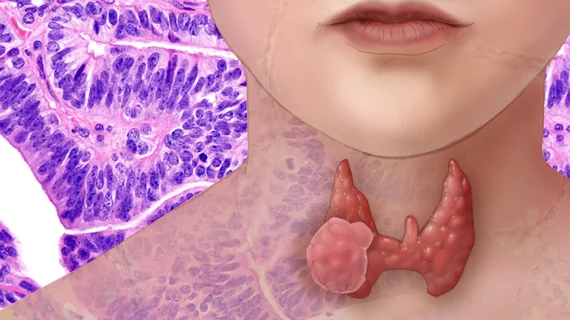Children see a higher rate of nodule malignancy in the thyroid than adults, clinicians confirmed in a recent Radiology study. Also, despite a handful of similarities in signs and symptoms, the younger demographic is faced with some unique biomarkers.
Danielle M. Richman, MD, MS, led a team of Brigham and Women’s Hospital and Boston Children’s Hospital researchers in a study of more than 300 patients between 2 and 18 years old, analyzing both the demographic and sonographic characteristics of nodules in the young population. Though thyroid nodules are less common in children than in adults—a 1 percent prevalence compared to up to 68 percent with high-resolution ultrasonography—the reported 26 percent rate of malignancy in the former group is notably higher than the latter’s 15 percent.
“Children who have been exposed to radiation therapy or chemotherapy have an increased risk of developing thyroid nodules and thyroid cancer, as do patients with certain tumor predisposition syndromes,” Richman et al. wrote. “When a thyroid nodule is identified in a pediatric patient at physical examination or imaging, it is important to recognize which nodules should undergo biopsy to avoid overtreatment of a benign lesion of undertreatment of a malignant one.”
Since treating younger patients can be so tenuous, the authors said, they aimed to more broadly classify nodules in pediatric patients in their study. The trial comprised 404 nodules found in 314 mostly-female patients, and a total 77 nodules, or 19.1 percent, were malignant.
Most malignant nodules were papillary thyroid carcinoma, Richman and co-authors reported, which was somewhat expected. And while there didn’t seem to be any significant differences between sexes or stages of puberty, several markers of the illness were uniform between pediatric and adult patients, like solitary, larger, nodules, those with taller-than-wide shape or lack of a smooth margin, solid parenchyma and the presence of speckled calcifications or abnormal lymph nodes.
“We found that most of the sonographic characteristics of a nodule associated with increased risk of cancer in adults also convey a higher risk of malignancy in children,” the researchers wrote. “[But] unlike adults in whom size is not associated with increased malignancy risk, in our series, the malignancy rate increased with increasing nodule size.”
Richmen et al. said fine-needle aspiration (FNA) of nodules with any suspicious sonographic characteristics is acceptable in pediatric patients—especially if they also present with abnormal lymph nodes.
“Consideration for FNA of any thyroid nodule in the pediatric patient is warranted, particularly for lesions with suspicious sonographic characteristics or in patients with abnormal lymph nodes,” the authors wrote. “Sampling of enlarged thyroid glands with innumerable calcifications is also indicated to diagnose or exclude the diffuse sclerosing variant of papillary cancer.”

